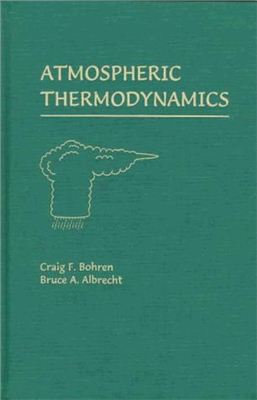Oxford University Press, Oxford, New York, 1998, 417 pp. - ISBN
978-0-19-509904-1
We tried to make our writing as lively as possible by using active constructions and by not hiding the fact that we are humans first, scientists second. We do not shrink from criticizing fallacies no matter how hallowed by frequent repetition. We use humor, irony, and sarcasm, all the techniques of the writing trade, to keep our readers interested. After all, they are mostly young people who are bombarded continually by striking visual images and vivid entertainment in many forms. Today's audience for textbooks is the most distracted, the least attentive, in the history of literate humanity.
Contents.
Preface.
Introduction: conservation of energy.
Ideal gas law: pressure and absolute temperature.
Specific heats and enthalpy: adiabatic processes.
Entropy.
Water and its transformations.
Moist air and clouds.
Energy, momentum, and mass transfer.
Selected References and Suggestions for Further Reading. Problems. Selected Physical Constants. Bibliography. Index.
We tried to make our writing as lively as possible by using active constructions and by not hiding the fact that we are humans first, scientists second. We do not shrink from criticizing fallacies no matter how hallowed by frequent repetition. We use humor, irony, and sarcasm, all the techniques of the writing trade, to keep our readers interested. After all, they are mostly young people who are bombarded continually by striking visual images and vivid entertainment in many forms. Today's audience for textbooks is the most distracted, the least attentive, in the history of literate humanity.
Contents.
Preface.
Introduction: conservation of energy.
Ideal gas law: pressure and absolute temperature.
Specific heats and enthalpy: adiabatic processes.
Entropy.
Water and its transformations.
Moist air and clouds.
Energy, momentum, and mass transfer.
Selected References and Suggestions for Further Reading. Problems. Selected Physical Constants. Bibliography. Index.

